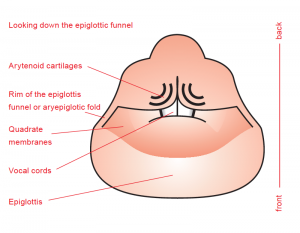An overview
Rattle takes place at level 3 or 5 (see ‘Various levels of the vocal tract‘) so rattle is produced higher in the vocal tract than creaking and distortion.
Rattle can be formed by vibrations at the arytenoid catillages, uvula, back of the tongue, the soft palate or by making the saliva/mucosa over the arytenoids cartilages vibrate. Rattle can be used alone or together with other effects, for example distortion. When a rattle is used alone it often sounds less ‘mean’ than distortion or creak. When used together with distortion it usually makes the distortion even stronger in effect.

There are 4 different rattles:
Arytenoid rattle
The arytenoid rattle takes place at level 3, the level of the arytenoids cartilages. The sound of the arytenoid rattle occurs from vibrations formed at the arytenoids cartilages.
| #241 (Female) #241 (Male) |
Saliva rattle
The saliva rattle takes place at level 3 and above. It is usually an arytenoid rattle plus some extra saliva which is made to vibrate along.
| #242 (Female) #242 (Male) |
Uvula rattle
The uvula rattle takes place at level 5, the level of the soft palate, uvula, back wall, back tongue. The sound of the uvula rattle is formed by vibrations at the uvula and at the soft palate.
| #243 (Female) #243 (Male) |
Back tongue rattle
The back tongue rattle takes place at Level 5. The sound of the back tongue rattle is formed by vibrations at the back of the tongue.
| #244 (Female) #244 (Male) |
Singers who use or used rattle
Joe Cocker, Ian Dury, Nina Hagen and Percy Sledge.
Adding rattle in a song
| #245 (Female) #245 (Male) |
